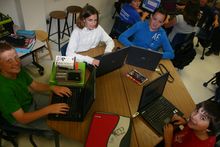Nashwaaksis Middle School
Students as Content Producers: 1-to-1 Laptop program at Nashwaaksis Middle School
By Jeff Whipple, Technology Learning Mentor
Nashwaaksis Middle School, Fredericton, New Brunswick, Canada.
 Teachers have a strong attachment to curriculum. In working with educators as we try to shift their narrative of learning to a model more appropriate for the 21st Century, the most significant barrier is the common refrain "but I have to cover the material".
Teachers have a strong attachment to curriculum. In working with educators as we try to shift their narrative of learning to a model more appropriate for the 21st Century, the most significant barrier is the common refrain "but I have to cover the material".
The journey to effectively leveraging technology for learning involves a huge shift in practice, but just what are the pedagogies that matter in technology-rich environments? Simply adding technology into the equation does little to change the equation. While there are inherent efficiencies in digitizing previous practice while maintain existing curricular expectations, this does little to nurture that all-important shift from teaching to learning. What 1-to-1 learning environments do offer is a chance to naturally promote shift from a teacher-delivered, content focused curriculum, to a student-centered environment.
During the past five years of their 1-to-1 student laptop program, teaching staff at Nashwaaksis Middle School in Fredericton, New Brunswick, Canada have been searching for ways to include students in the conversations about learning. The millennial generation is participatory in nature. No longer content to be passive consumers of information, they demand to interact with their media experiences. Their school experiences should be no less rich. Increasingly, learning leaders at NMS have given students a change to participate in the design and delivery of the curriculum.
While not abandoning core fundamentals, many NMS educators have slimmed down their curricular expectations over time, choosing instead to identify the most critical outcomes, which are drilled down at the expense of breadth. By utilizing a variety of web tools to focus on students as content producers for an authentic audience and building collaboration between learners, many teachers engage students in an information-rich learning experience.
 Technology-rich learning environments where students have ubiquitous connectivity allow staff to place a particular emphasis on three specific "outcomes"; preparing students to be literate in a networked and digital information environment, to develop and manage learning networks, and to nurture a positive digital footprint.At Nashwaaksis Middle, teachers have explored pedagogies that include utilizing social networking tools like Facebook to meet students where they participate and connect, to setting aside the textbook in favor of having students collaboratively develop and utilize learning networks to research and produce wiki-based collective classroom resources and interact directly with authors and other community figures through web-based learning opportunities.
Technology-rich learning environments where students have ubiquitous connectivity allow staff to place a particular emphasis on three specific "outcomes"; preparing students to be literate in a networked and digital information environment, to develop and manage learning networks, and to nurture a positive digital footprint.At Nashwaaksis Middle, teachers have explored pedagogies that include utilizing social networking tools like Facebook to meet students where they participate and connect, to setting aside the textbook in favor of having students collaboratively develop and utilize learning networks to research and produce wiki-based collective classroom resources and interact directly with authors and other community figures through web-based learning opportunities.
An additional focus at Nashwaaksis involves connecting students for learning through global collaborative projects. Over the past three years NMS teachers and students have participated in projects with learners at almost twenty schools in a dozen countries. These projects reach across a variety of traditional subject areas, and focus on having students connect for cross-cultural understanding and subject-specific sharing of understanding. Teachers have not abandoned the designated curricular expectations. All these projects and activities are pulled from traditional curricular expectations, molded to engage and include students in the learning conversations. In addition, discussions of curriculum would be incomplete without a look at assessment of learning. While traditional assessment tools continue to play a role at NMS, increasingly teachers are utilizing more authentic assessment techniques to measure student learning, including rubrics and peer assessment.
For instance, one innovative teacher brought a civics class to life by having students self-identify into like-minded groups based on personality traits, researching current party policies, developing names, ideologies, and platforms for their new parties, developing websites and other campaign materials and holding an election within the classroom. The authentic assessment involved extra marks for votes and the winning team got to "run" the classroom for a day, including directing curriculum.
NMS students are subject to the same provincial assessments as students at other schools. The belief among staff is that by focusing on authentic learning for a purpose and project-based, collaborative studies and placing less of a focus on fact-based learning students will perform no worse on these assessments while developing the skills, understandings and habits that provide a basis for continued learning success.
Technology-rich learning environments provide an opportunity to explore a fundamental shift on how students interact with information and each other for learning.By creating participatory learning environments where students shift from singular consumers to collaborative producers of content to be shared with an authentic audience for a real purpose, we run a better chance of allowing our students to develop a passion for learning.
Jeff Whipple is a Technology Learning Mentor for Nashwaaksis Middle School in Fredericton, New Brunswick, Canada. Jeff blogs at http://edutrails.edublogs.org, and loves to share through conferene presentations and workshops.
The Nashwaaksis Middle School is one of the first schools to have a 1-to-1 laptop program in New Brunswick, Canada. Now in it's fifth year of experience with student laptops, Nashwaaksis Middle provides a 1-to-1 environment for almost 600 students. "Nasis" has been chosen as the 2009 Spotlight School at the Lausanne Laptop Institute in Memphis, Tennessee from July 19-21, 2009.
To read the next Global Story click here






